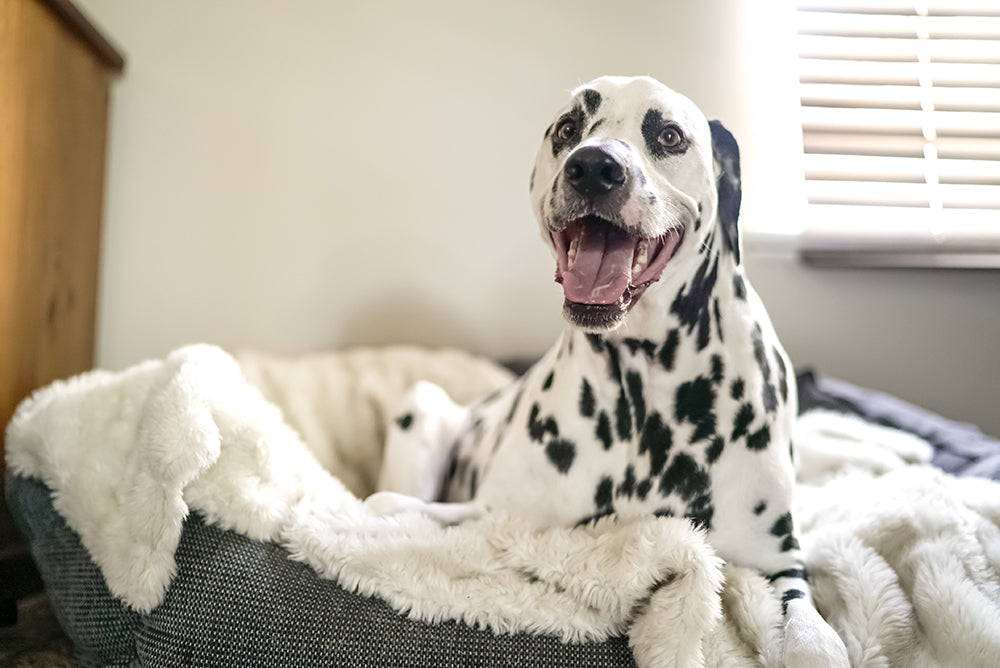
Can Dogs Be Allergic to Their Beds?

By Paula Fitzsimmons
If you’re living with a sneezing, itchy dog, her bed may be to blame. Dog beds, especially if not regularly washed and replaced, can be a major source of dust mites, which can trigger your dog’s allergy symptoms.
If you suspect that your dog is allergic to something in your home, learn how her bed may be harboring allergens—and more importantly, how choosing the right type of bed can provide relief.
Why Your Dog’s Bed May Be Triggering Her Allergies
If your dog is allergic to her bed, the filling is likely the culprit. “Some of the contents can cause an allergic reaction, especially if the dog has had the bed for a long period of time. Over time, there can be an increase in house dust mites and even fleas,” says Dr. Mitchell Song, a board-certified veterinary dermatologist with VetMed in Phoenix, Arizona.
Dog beds are usually filled with synthetic or latex memory foam. Although both of these are resistant to the growth of house dust mites and molds, they can still be problematic. “It’s the accumulation of pet skin cells on the surface of the foam and under the fabric covering that allows the growth of house dust mites. While the foam beddings will not facilitate the growth of house dust mites or molds within the foam, they may accumulate on the surface if skin cells and moisture are present,” says Dr. John Gordon, a board-certified veterinary dermatologist with MedVet in Columbus, Ohio.
Choose the Right Outer Fabric
Dog beds and mats come in a variety of outer fabrics, including suede, shag faux fur, micro suede shearling, cotton, wool and polyester, says Dr. Song. Although the bed’s filling is usually the source of allergens, experts say some fabrics are more likely to trigger your dog’s allergies than others.
“Manufacturing synthetic fabrics requires certain chemicals and processes. These chemicals, such as flame retardants, are known to be allergenic. Some fabrics also allow the accumulation of dust mites, mold, mildew and bacteria that can exacerbate skin sensitivities,” says Dr. Hyunmin Kim, veterinary staff manager for the ASPCA Community Medicine Department.
Fabrics made of 100 percent cotton, hemp or tightly woven microfiber fabric are less likely to cause an allergic reaction, she says. “Hemp is a naturally grown crop that is not sprayed with chemicals or pesticides and is particularly resistant to mildew, sun damage and tears.”
How a Hypoallergenic Dog Bed Can Help
One key feature of hypoallergenic dog beds, like the Furpezoo Waterproof Dog Beds, is that they tend to be made of thicker foam (which is also a good source of support for arthritic patients).
“A denser foam mattress will be less likely to harbor dust mites, especially if there is a cover that has a weave tight enough to prevent mites from penetrating through. Looser filling and less-dense foam allows more dust and dust mites to reside in it,” says Dr. Kristin Holm, a board-certified veterinary dermatologist with Veterinary Dermatology Consultation Services in Johnston, Iowa.
Dr. Kim says some hypoallergenic fabrics are made from a tightly woven microfiber that blocks the passage of allergy-causing dust mite waste. They’re also easy to clean, which she says may help prevent bacterial skin infections in any dog. In general, however, “Any fabric that is easy to clean, not treated with chemicals and easy to keep free of mold, dust, fleas, dander and dust mites is a good choice.”
The Importance of Regularly Replacing Your Dog’s Bed
If your dog is sneezing and itchy, the dust mite allergen, which Dr. Gordon says is the most common positive environmental allergen in skin allergy-tested patients, may be responsible. “A veterinary university study that evaluated the presence of house dust mites in pet beds found a significant increase in the amount of house dust mite allergen collected in pet beds older than one year.” This was true regardless of how often the beds were cleaned or their type, he says.
Taking precautions to reduce your dog’s exposure to house dust mites in the home will help reduce the severity of their allergy symptoms, says Dr. Gordon. “Because most pet beds will be cleaned less often and dogs do not wash before going to bed, it is reasonable to consider purchasing a pet bed at least annually.”
Even if you plan on buying your pup a new dog bed every year, experts recommend opting for beds that can be easily cleaned, like those with machine-washable covers. (Some beds even have inserts that are machine washable.)
“When the cover is removed completely it is also important that it is completely dry before putting back on the bedding,” advises Dr. Gordon. Experts recommend washing bed covers each week, especially if your dog is allergic to dust mites.
If you find yourself asking, “Why is my dog sneezing and itchy?” with increasing frequency, the solution may be as simple as washing or replacing her bed. Ask your vet if a hypoallergenic dog bed is a good option.








